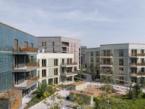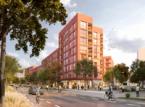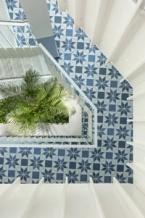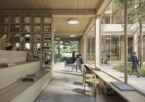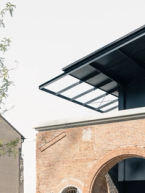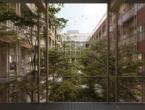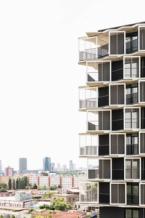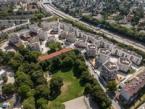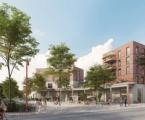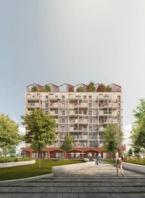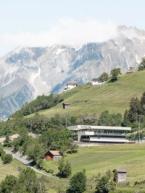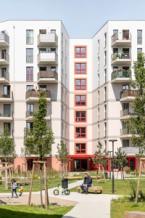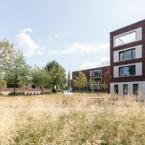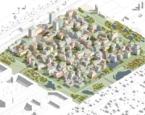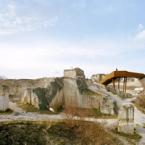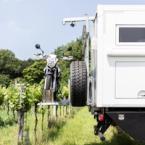The design delivers on the promise of a future of flexible work by creating an office building as an open-shelf system that offers multiple versatile green spaces: Expanded work areas on balconies, terraces, or a garden house not only provide for a perfect setting for collective activity; the office complex also makes a valuable contribution to the local microclimate and biodiversity. Guiding ideas such as resource-saving construction, climate-friendly operation, and foresighted life-cycle planning are the backbone of a design with an attitude.
Office Complex Kruppstrasse
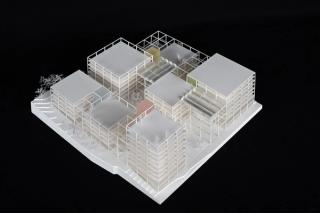
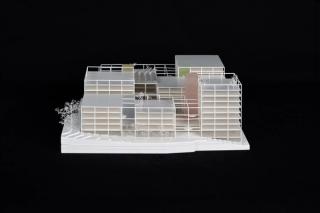
Planning: AllesWirdGut
Project stages: 1
Client: Wöhr+Bauer
Competition: Feb. 2021 (2nd prize)
GFA: 33,446 m²
Team: Cristina Vlascici, Dorotea Malnar, Janek von Zabern, Karolina Pettikova, Philipp Stauss,
Rita Roznar, Valentin Schmid
Landscape architecture: grabner hubber lipp
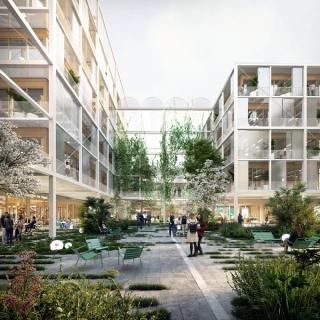

The main structure of the seven-building complex consists of wood, while the thermal-storage prefab-slab ceilings and the below-grade substructure are made of lower-emission concrete with slag cement. Together with the modular construction—individual materials can simply be removed and reused in the future—the flexibly usable and easily adaptable rental units make for longevity of the new working environment. The façade of the office complex takes up the rational ground-plan grid and extends the ground-floor garden to the vertical through a circumferential compartmentalized scaffolding. Sliding doors, unusual for offices, make it possible to step out on the wraparound balconies thereby created.
Transparent sliding panels in the outermost building skin make this exterior circulation and communication zone also a climatic buffer space in the cold season. Closing the panels creates winter gardens that store solar energy and thus help reduce heating costs. In summer, the panels are kept open. Projecting balconies provide direct shading and good daylighting quality without glare. Between the upper levels, covered footbridges trained with vines (garden houses) create transition areas with an ecological surplus value. Simple glass roofs with photovoltaic modules offer weather protection and generate energy that can be directly used, stored, or fed into the public grid.

Site plan
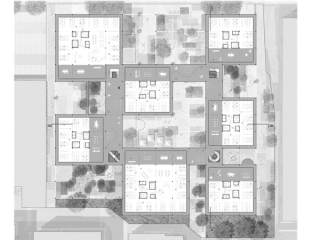
Standard floor plan

Axonometry
Visualization: Patricia Bagienski / AllesWirdGut, Illustrations: AllesWirdGut, Model: mattweiss
Hitachi Columbus Campus
Sustainable, simple, beautiful!

AllesWirdGut Architektur ZT GmbH
Untere Donaustraße 13–15
1020 Vienna, Austria
AllesWirdGut Architektur ZT GmbH
Jahnstraße 18
80469 Munich, Germany
AllesWirdGut Architektur ZT GmbH
Jahnstraße 18
80469 Munich, Germany
Associated Partners: DI Andreas Marth / DI Christian Waldner (CEO) / DI Friedrich Passler (CEO) / DI Herwig Spiegl
Member of the statutory professional association of architects and consulting engineers, Vienna,
Lower Austria and Burgenland: ZL 91.519/79-I/3/02
Member of the Bavarian chamber of architects
Commercial Court Vienna / Reg.No.: 228065s / Vat No.: ATU 55987702
Erste Bank Vienna / IBAN: AT67 2011 1280 2411 2400 / BIC: GIBAATWWXXX
